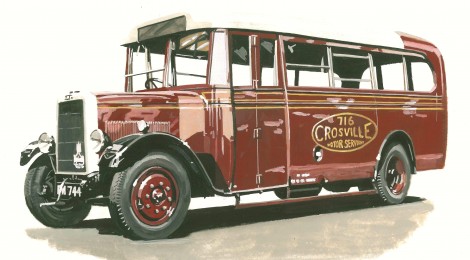
A long day in Cheshire…
Today Tony, Brian and I met a party from Historic Vehicle Restorations and our Leyland Cub’s previous owner for a session preparing it for collection from its resting place of the last 30 years and movement to HVR’s workshop near Byfleet for restoration. We went well tooled up, and Brian and Tony did a superb job in readying the Cub for its journey. Here, in photos, is a flavour of the day…
Below: An unpromising start! The bus had been undercover, though the shed had long since collapsed (fortunately not on to the Cub) and left it exposed to the elements. All of the side pillars have rotted away, some panels remaining but having fallen clear. The interior was littered with debris and remaining components (including one bonnet side) and so the enormity of the project has become very clear!
Below: The remains of the roof board, fitted during 716’s time as a builders office (and possible showroom – there were tiles on the floor and evidence of attempts to make it into an office associated with the supply of new housing stock). Needless to say we won’t be reinstating this feature!
Below: Debris from the interior was sorted and tidied, revealing useful remains that can be incorporated into the restoration.
Below: With the interior cleaned, we could see what we were dealing with and take measurements that will be important when looking to the conversion work required to accommodate wheelchairs. An original wheel arch dominates this view.
Below: All of the brakes were seized, so Brian set to, with Tony assisting the process of jacking the bus, removing wheels, loosening and removing brake shoes (where he could get into the drums) and freeing off the hubs so that wheels could be refitted in readiness for moving the bus to a location for loading.
Below: A close up of the nearside front, sans brake shoes and before refitting of the wheel.
Below: Brian at work on the stubborn rear offside drum, which would not yield to his percussive technique, even when a large hammer was applied! The half-shafts were removed easily however, and were found to be in very good condition.
Below: The nearside rear wheels, flat and buried!
Below: Tony at work making an internal framework to brake the bus’ Brush body for transit – retaining its original roof was considered very important and so the frame supports the roof cant rail, stops lateral movement as well as fore and aft.
Below: One of the side panels – possibly a later skinning as there is no evidence of the maroon livery beneath the remnants of the green.
Below: A view underneath – the chassis is actually in good condition with surface rust but nothing alarming! Note the propshaft and differential. Withdrawing the half-shafts disconnects the wheels from these, reducing drag and also preventing damage in case the diff or gearbox are seized.
Below: A boarding passenger’s view of the driving position.
Below: The six cylinder petrol engine appears not to be seized, but will clearly require considerable investigation as to its potential re-use in this project.
Below: A view of Tony’s bracing structure.
Below: A local farmer provided his tractor to give the Cub a tug, to see if the remaining stuck brakes would come free. One did, one didn’t! No matter, the ground being soft and the tractor powerful! This enabled the seized wheel to slide without damage.
Below: Ready for collection and removal to Byfleet for the restoration to commence… This move is due to take place shortly.
Below: A rear view, showing the rather ugly extension added during its life as an office.
Below: A view we can use to compare with progress as the restoration commences and, ultimately, when the bus is completed… It promises to be a big change!

























A big change and a big challenge, too, Paul. But having seen what you and your colleagues are capable of, it will be great to make the comparison when the project is completed. Best of luck!